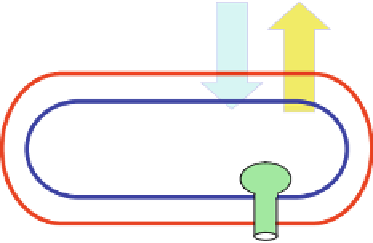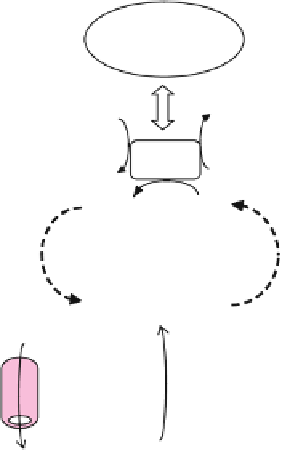Biomedical Engineering Reference
In-Depth Information
and functionalities, the brain has a high energy demand which
is mainly fulfilled by the energy metabolism at the cellular level
through adenosine triphosphate (ATP) production and utiliza-
tion
(1-8)
.
The vast majority of ATP formation relies on the oxidative
phosphorylation occurring inside the mitochondria. The activity
of cytochrome oxidase, a key mitochondrial enzyme of oxidative
energy metabolism, is regulated by the cell functional activities
and their energy demand
(9, 10)
. At normal condition, the cere-
bral oxidative phosphorylation is expected to be tightly coupled
and supported by the oxygen metabolism.
Figure 15.1
illustrates a simplified schema showing the
major metabolic processes and ATP energy transportation occur-
ring at various subcellular compartments and the associated
hemodynamic processes for supporting normal brain function.
Brain function
and activation
K
+
Na
+
/K
+
ATP
ase
Na
+
R5
Pi + ADP
ATP
R4
PCr+ ADP
ATP + Cr
R3
Mitochondria
PCr + ADP
ATP + Cr
R2
Matrix
Pi + ADP ATP
R1
O
2
+ Pyr
H
2
O + CO
2
Cytosol
Me mbran es
H
+
H
+
Cellular
membrane
Pyr Lactate
O
2
Glc
Intra-cellular space
Extra-cellular space
Capillary
& BBB
Hb HbO
2
Glc
CBF
Fig. 15.1. Schematic diagram of simplified major brain network involving metabolisms
and hemodynamics occurring in the capillary, subcellular compartments including the
mitochondria and cytosol spaces. Oxygen dissociates from hemoglobin (Hb) and enters
mitochondria and it is metabolized with pyruvate (Pyr) which is converted from glu-
cose (Glc). This oxygen utilization via Reaction 1 (R1) is tightly coupled with four ATP
reactions for generating ATP (R2), consuming ATP (R5), transporting and buffering ATP
energy via the paired CK reactions (R3 vs. V4). These four ATP reactions constitute a
chemical exchange network PCr↔ATP↔Pi. This neurovascular-metabolic coupled net-
work is essential for brain function.




















